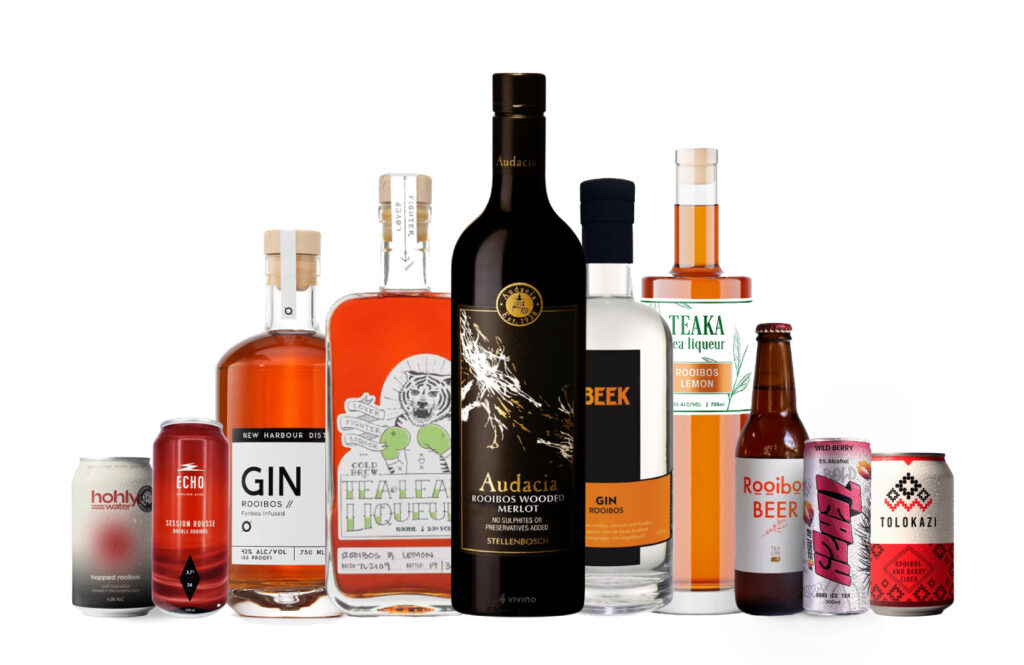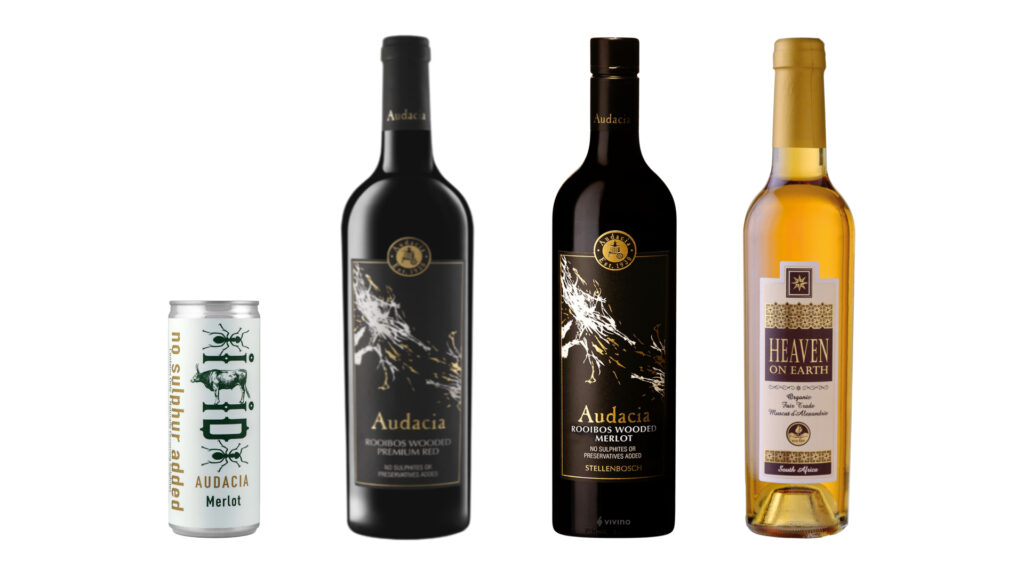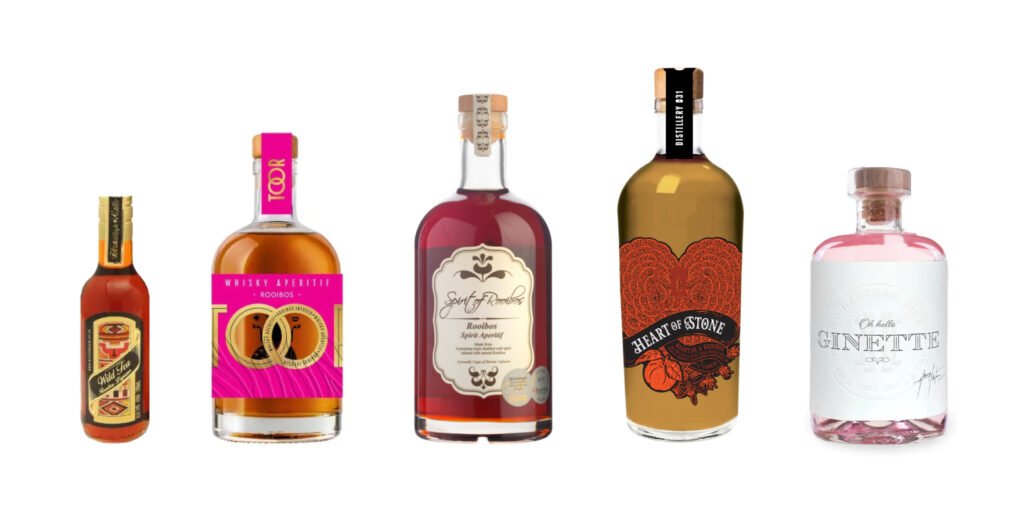Historically, the global popularity of rooibos as a herbal tea has radiated outward from its homeland, South Africa, to the rest of the world. Matching this movement, in the last 30 years a second wave of rooibos tea being used in other applications followed in its wake as its health-giving properties became known internationally. In recent years a ‘third wave’ of rooibos use has given rise to the inclusion of rooibos in a new way, in alcoholic beverages.
In this article, we provide an overview of the innovations taking place in this sector, and share examples of these as a follow-up to our earlier article on Rooibos In The Beverage And Wellness Sectors, published here in 2021. We also provide a breakdown of the variety of new alcoholic drinks containing rooibos by type, which is necessary in light of the explosion of this kind of beverage over the last two years. Whilst the picture in 2021 consisted of a few examples of craft beers, gins and liqueurs, as of late 2023 the variety and number has increased to the extent that there are now dozens of examples in each category.
From rooibos wines in South Africa and on to a growing list of aperitifs, spirits and RTDs elsewhere in the world, it is evident that this is a picture that is constantly changing and diversifying. Driving the use of rooibos in wine, beers and spirits is a global trend for makers and brands to seek out interesting and lesser-known types of floral and herbal ingredients. In turn, this has led to experimentation with rooibos in order to meet what appears to be a growing global appetite in the alcoholic drinks marketplace.
Transcending its status as a herbal tea
With naturally sweet, nutty, and slightly smoky notes, makers of alcoholic drinks – as well as bartenders and mixologists – have naturally been drawn to rooibos for its versatility and ability to complement various spirits. This versatility has driven interest in experimentation – at the level of mixologists seeking out exciting new pairings for cocktails, and also further upstream in the world of brewers, distillers and increasingly, among brands creating ready-mixed alcoholic RTDs. This growth points to an interesting new frontier for rooibos which rides on its reputation as an ideal base ingredient for beverages, and one which brings with it certain aspects of a functional beverage that provides health benefits.
Taking this further, makers of alcoholic beverages have begun to investigate the chemistry of rooibos, and their experiments have begun to yield interesting and promising results. Among the foremost examples of innovation in this area is the use of rooibos in wine.
Rooibos in red wine: a natural pairing
With its naturally amber-to-red colouration and a flavour profile that is somewhat woody, slightly sweet and fruity, the organoleptic qualities of rooibos make for a logical point of interest for winemakers. Red wines are particularly good match for this flavour and colour profile, to the extent that in assessing red wines, sommeliers have been noted to make mention of ‘overtones of rooibos’ in red wines from a variety of regions. However it is in the potential for rooibos to act as a preservative that has spurred on investigation of its use in viticulture, as rooibos contains chemicals that make it possible for winemakers to forego the use of sulphites.
With South Africa’s wine industry having a history that extends as far back as the late 1700s, and with the rooibos region (the only area of the world that it grows) lying in the same province, it comes as no surprise that experimentation with it in wine would come about. As winemakers have explored this unusual application of rooibos, their research has identified that Aspalathin is at the heart of the antioxidant properties that make sulphur-free wines possible.
In 2014 the Audacia wine label was the first to market with this innovation, breaking new ground by utilising rooibos in the production of a red wine. As a result, they were able to market their Merlot as sulphite-free, a point of distinction that appeals to a growing body of wine lovers who are either allergic to sulphur, or seek out wines made as organically as possible. In the process, the label was able to establish its product as ‘hangover-free’, as a point of interest to those who have an adverse reaction to the sulphur usually used by winemakers in order to prevent wine from spoiling in the vat. In addition, by creating the wine naturally instead of resorting to the use of sulphites as an intervention, the taste of the cultivars used is preserved.
An additional benefit of the use of rooibos in wine production is that the delicate fresh and fruity notes of red wine are enhanced, due to rooibos adding its own sweet berry flavours during the fermentation process. Interestingly, this organoleptic aspect has seen the Stellar Organics winery, whose vineyards are located in the rooibos-growing region, to create a Dessert Muscat wine from grapes that are dried on rooibos straw to impart its distinctive flavours prior to pressing.
Following on the groundbreaking introduction of a rooibos-wooded wine by Audacia, the label has since added a Rooibos Wooded Premium Red to its range. Other winemakers have taken note, and as a result more rooibos wines are now coming to market. These now include one of South Africa’s largest wine companies, KWV, whose Earth’s Essence range features a rooibos Pinotage. With these wines having won awards internationally and generating interest from lovers of organic wines, this is an application of rooibos that could be reasonably expected to show growth as further development and research take place on a commercial scale.
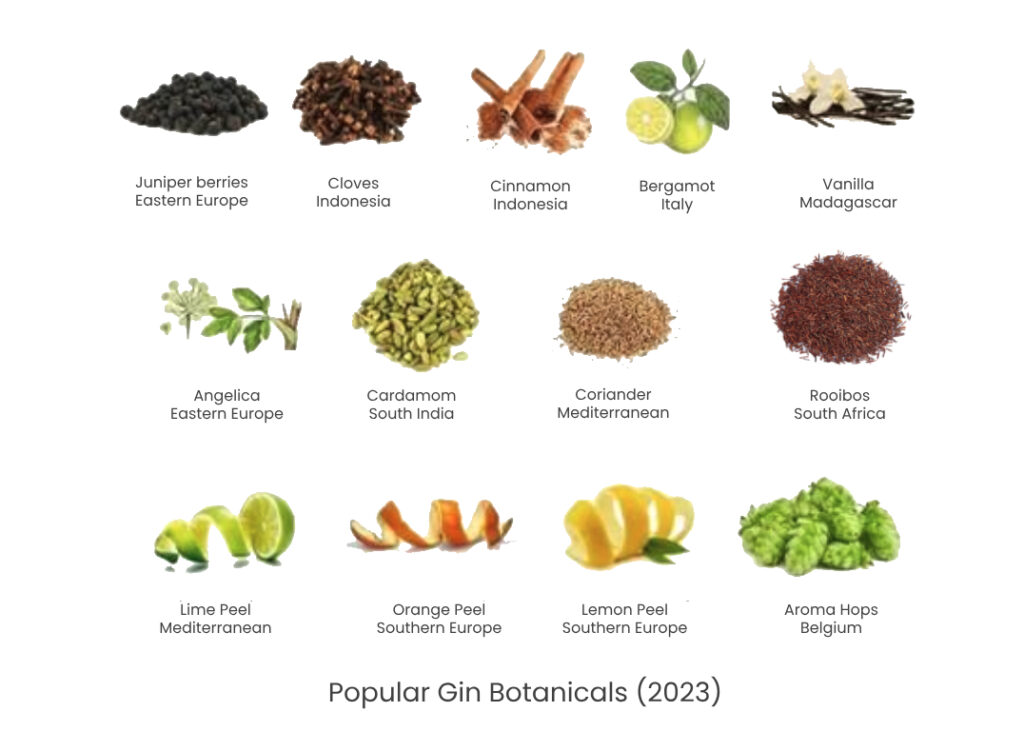
Rooibos gins: naturally bold botanical experimentation
With winemakers and distillers often found under the same roof or collaborating in the creation of fortified wines and spirits, so the use of rooibos in alcoholic beverages such as spirits has followed on naturally from its use in wine.
In the same manner, with gin having its roots in the use of botanicals to provide herbal and floral notes to its flavour profile, it was perhaps inevitable that the investigation of rooibos in the making of gins would come about.
In keeping with the boom in the creation of craft gins worldwide, so the search for botanical ingredients has seen rooibos come to the fore. The result, much like the trajectory of rooibos in wine, has seen initial products being brought to market by South African distillers and increasingly by makers elsewhere in the world.
As a notable standout, the gin sector appears to be where the greatest amount of experimentation and uptake in terms of the use of rooibos in alcoholic beverages is taking place.
As of early 2024, our investigation of this category of gins shows that there are now upwards of 20 different types of rooibos-based gins on the market – and of these, South African gins unsurprisingly consist of the greatest number. That said, a growing number of gins from elsewhere in the world are now making inroads into a market which is highly competitive and has long been distinguished by its innovative use of botanical ingredients.
Whether as a primary flavour ingredient, or in combination with complementary botanicals such as honeybush, buchu (another indigenous South African botanical much sought-after by distillers) and fruity ingredients such as citrus, rooibos now looks to be taking place as a staple in the production of gins globally. And as a natural and logical choice of botanical, early adoption was first seen amongst the burgeoning number of commercial and craft gin makers in South Africa.
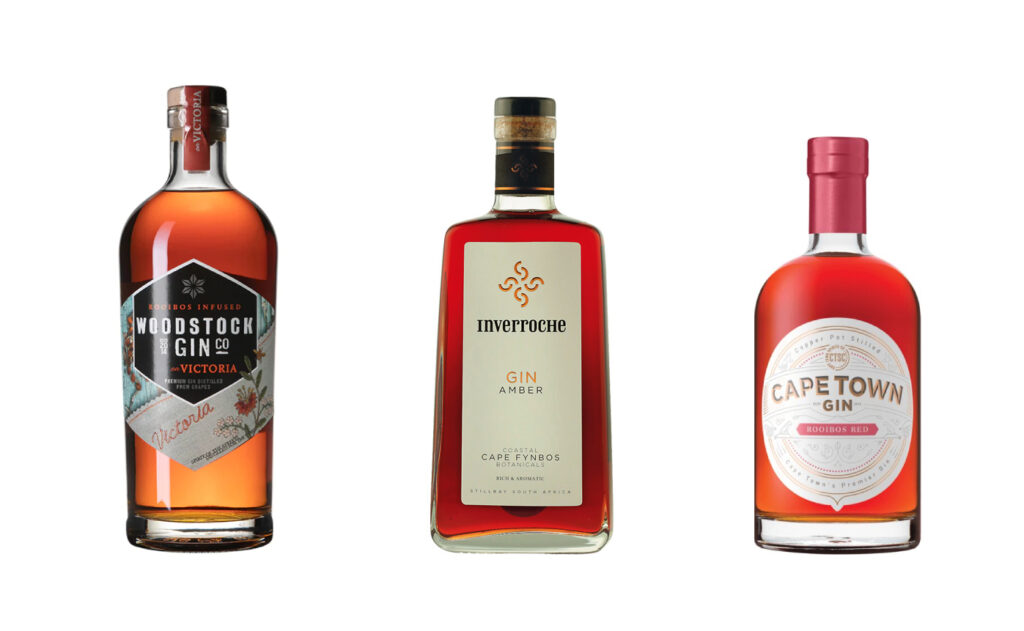
Among the leading South African gins which prominently feature rooibos as a primary ingredient or in combination with other fynbos species of plants are Inverroche Gin, whose Amber variant remains one of the most highly-awarded gins in the country (and indeed elsewhere). In the same vein, early craft gin brands such as Cape Town Gin Co and Woodstock Gin were also amongst the first to turn to rooibos as a local ingredient that is perfectly suited to the creation of gins with distinctive floral and botanical notes.
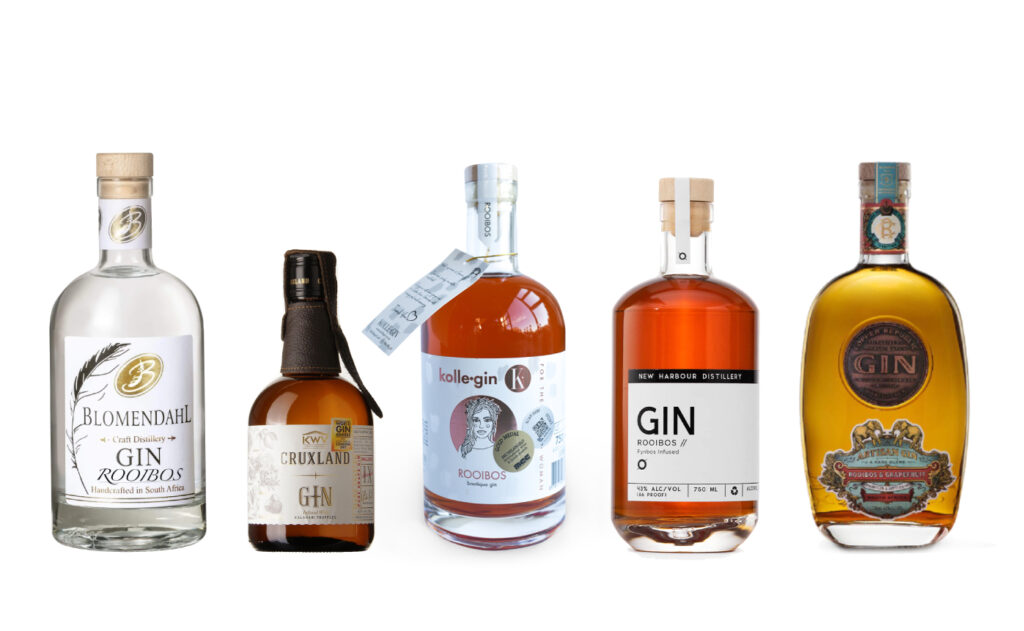
Following suit and in keeping with the growth of the gin category in South Africa, are a flush of newcomers to the category. Some of these, like Blomendahl Gin and Cruxland Gin (a label within the KWV stable), have their roots in well-established and highly-awarded wineries.
Others such as East End Beverage Co, New Harbour, Copper Republic, Flivver and Still Oaky have risen to prominence as small-batch distillers who appeal to a niche market and wear their experimentation proudly on their sleeve. Whether combined with pairings such as grapefruit, honey, blood orange or buchu, these are quintessentially South African gins that highlight rooibos as an ingredient both to leverage interest in rooibos, and also simply on the basis of its suitability as a botanical.
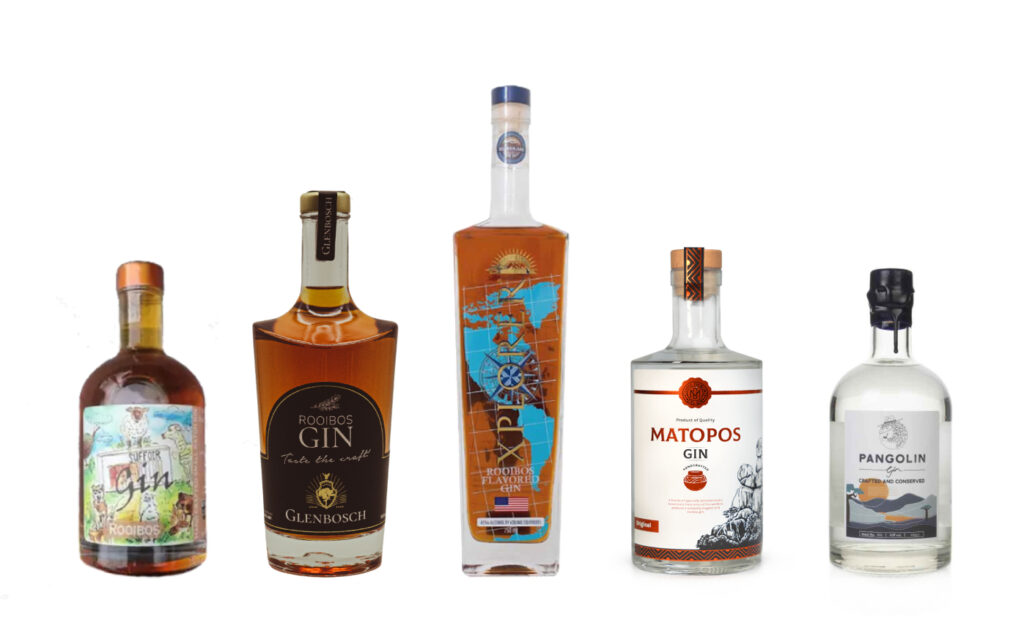
Further abroad, the landscape of rooibos gins has grown in step with the popularity and expansion of craft gins in general as a sector. Notable examples in this area consist of two new gins from Australia, consisting of Suffoir, and rival label Glenbosch – and whilst the USA does not have a significant history as a major gin-producing country, the Xplorer brand has recently brought its rooibos-flavoured gin to the North American market.
In the area of the UK and Europe, a taste for both gin and experimentation has seen new gin labels embracing the use of rooibos. In the UK, notable examples include Pangolin Gin, Matopos London Dry and Brentingby, whose gin blends the taste of rooibos and baobab to create a pink gin. Across the English Channel in the Netherlands (the original home of gin), the Beek label has expanded its range with a new variant in the form of its Rooibos Gin.
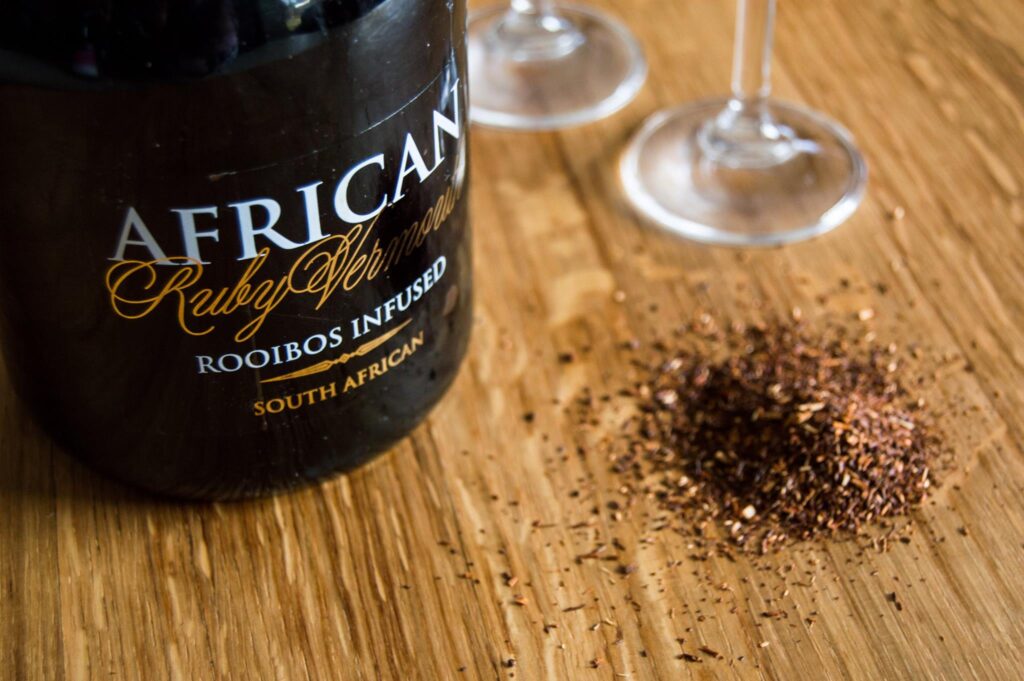
A growing taste for rooibos apéritifs (and liqueurs)
Being a regional speciality, it is again in South Africa that the use of rooibos has been pioneered in sherry, port, and an expanding range of liqueurs and spirit apéritifs. Notable in this area is the rooibos-infused Ruby Vermouth by the Klawer label.
However, as with the growth in popularity of rooibos generally across the globe, the development of apéritifs and liqueurs that make use of rooibos in their primary or secondary phases of creation is not limited to South Africa.
Rather, it appears that the well-established culture of drinking apéritifs in Europe and the UK has driven interest in the novel inclusion of rooibos in the formulation of these popular drinks. In this area, with rooibos’ amber to red colouration and botanical organoleptic profile being an ideal match for the colour and taste of apéritifs is an asset, and makes it a natural choice for makers experimenting with new ideas and ingredients.
In line with the use of botanical ingredients in gin, so the use of rooibos in alcoholic beverages such as those designed to aid digestion has also seen growth. With the appetite for apéritifs in the EU market particularly robust, makers in this area consist of two main sources: those produced in South Africa and exported, and those made in the EU using imported rooibos as an ingredient.
On the back of South African palates growing more adventurous, a number of makers have expanded their ranges to include apéritifs and liqueurs, with these often including rooibos. Examples of expansion in this category include Toor Whisky Apéritif, Spirit of Rooibos, Wildebraam Wild Tea Liqueur, Distillery 031’s ‘Heart of Darkness’, and Harry Hartman’s Ginette Rooibos Gin Apéritif. With direct access to rooibos producers, it could be reasonably anticipated that this market segment in the South African liquor industry may yet produce many more variations on this theme.
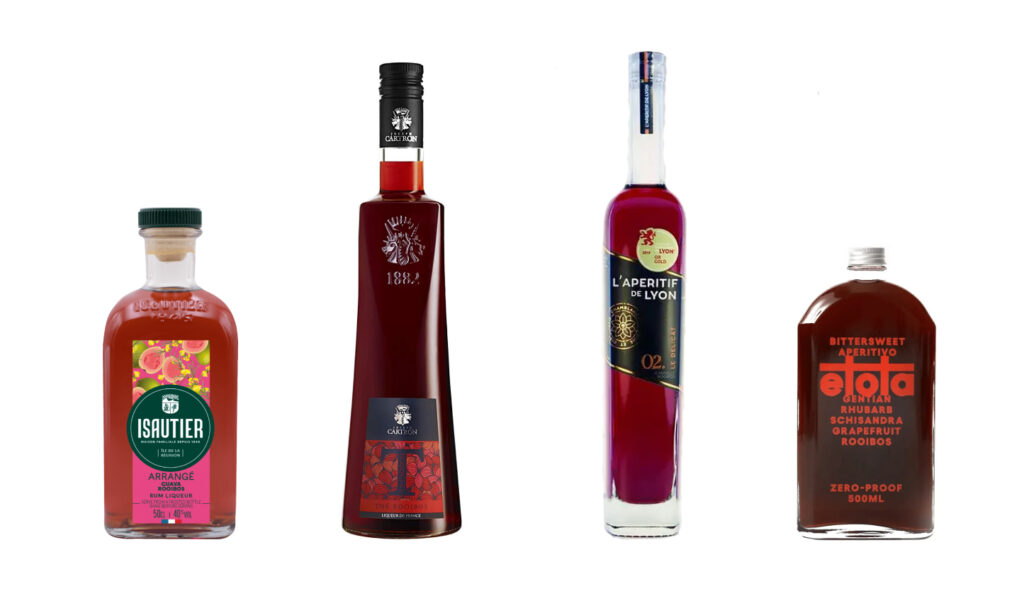
Beyond this emerging African cluster of rooibos apéritifs and liqueurs, markets in the EU and USA – and as with gins, Australia – are also seeing makers using rooibos in the creation of digestifs and cocktail bases. Among these are Isautier, whole Guava Rooibos liqueur is made in Reunion and shipped to France, which is also where the noble Cartron winemaking family of Burgundy have produced their Cartron T Rooibos Liqueur. Not to be outdone, in the Lyon region the L’ Aperitif De Lyons company has recently added a rooibos product to their range, with it being awarded two gold medals in 2023 as an outstanding newcomer.
Worth mention in this category – and though in fact alcohol-free – is Australia’s Etota apéritif, which features rooibos prominently amongst its ingredients and has won numerous awards over the last two years.
This article is the latest in a series designed to provide tea industry buyers and brands with accessible reference material on rooibos tea. For further overviews of various aspects of the rooibos industry and rooibos as a herbal tisane, see these other articles here on our website:

